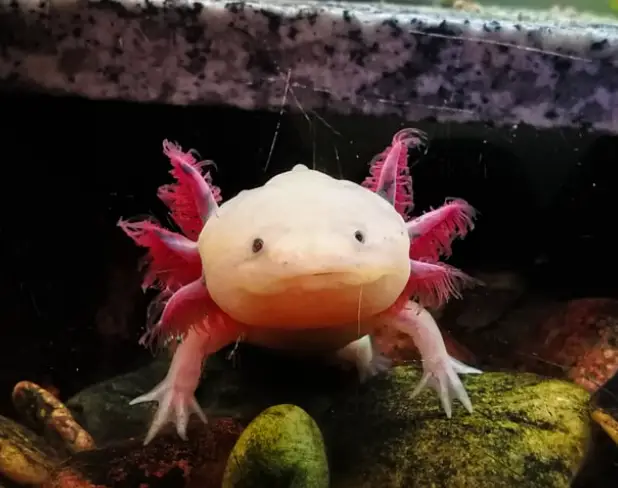However, axolotls’ propensity for reproduction attracts a lot of humans. When it comes to partners, axolotls aren’t exactly fussy, and fertilized eggs can develop just a few hours after mating.
Female axolotls can lay a large number of eggs at once, making them the perfect pet for anyone looking to start a breeding business or just build a small axolotl population.
Claiming that breeding axolotls can be very time consuming and a little complex. It can be incredibly daunting to experience a female’s spawn because there are so many eggs inside. It can be difficult to tell the difference between good, fertilized eggs and bad, unfertilized eggs. But this is a crucial step in the procedure.
Check out the information below if you want to start breeding axolotls or if a particularly rascally pair of axolotls just caught you off guard. We have discussed the entire breeding process as well as the distinctions between fertilized and unfertilized eggs to help you understand your axolotls a little bit better.
What Do Axolotls Eggs Look Like?
Axolotls lay eggs that are small and translucent, about the size of a pea. They are usually laid in clusters and are attached to plants or other objects in the water. The eggs are surrounded by a thin, gelatinous casing that helps to protect them. As the eggs develop, they become more visible, and it is possible to see the developing embryo inside.
The eggs typically hatch within 2-4 weeks, depending on the water temperature. When the eggs hatch, the young axolotls, called larvae, are about the size of a grain of rice and have gills, a tail, and small limb buds. They will continue to grow and develop until they reach adulthood, at which point they will begin to develop lungs and lose their gills.
It is important to provide a suitable environment for the eggs to develop, as axolotls are sensitive to changes in water temperature and quality. It is also important to handle the eggs carefully, as they are delicate and can be easily damaged.
How To Tell If Axolotl Eggs Are Fertilized?
Even while female axolotls don’t naturally produce unfertilized eggs, there is a possibility that some of the eggs in a given spawn will be either unfertilized or dead.
Normal axolotl eggs have a solid black or white spherical inside of their transparent casing, indicating that they are fertilized and healthy. This spherical is typically indicative of a fertilized axolotl egg. Early on, it might be challenging to separate good eggs from bad eggs.
However, after some time, you can quickly distinguish between good eggs and terrible eggs. Good axolotl eggs will change to have thin, black or white cylinders inside. The axolotl’s head is located at one end of the cylinder, which will be slightly chunkier than its opposite end. The tail is located at the other, more pointed end.
A poor axolotl egg will have a much more cylindrical form inside the translucent shell. These eggs will have a larger, murkier white glob inside of them, and the shell may also look fairly fuzzy because mold may start to form on it.
If this occurs, it’s a good idea to sort out the undesirables from the desirables. A grown axolotl can be fed an unsuitable axolotl egg if you want to get rid of it.
How Many Eggs Do Axolotls Lay?
Fertilization can take place right away or take several days. Then, female axolotls can lay anywhere between 400 and 1000 eggs at once. Although female axolotls can reproduce numerous times, doing so is very taxing on their bodies.
How Many Axolotl Eggs Will Survive?
It is incredibly difficult to estimate an axolotl egg’s chance of survival. The care they receive in their first several months of life will largely determine how many healthy axolotls survive.
However, respectable axolotl breeders typically only grow 20 to 30 axolotl at a time, so with that said. Although 200 hatchlings could be kept in a 20-gallon tank, they would need to be divided into much smaller groups after a few days.
Because of this, a lot of breeders decide to murder a lot of the eggs that the mature axolotl produces. You can achieve this by freezing them or by feeding them to an adult axolotl.
What To Do After The Axolotl Eggs Hatch?
The axolotl babies must be fed from the second day onward in order to prevent cannibalism in the tank. You must give them small freshwater insects that fit the size of their mouth, such as Artemia nauplias, live daphnia, or live baby bloodworm (midge larvae), morning and evening until they are about 4 centimeters long (when their front legs will develop). At that point, you should feed them small worms of living
If you wait a short while to feed the larger ones, they might assault them. They must be separated in their own Tank until they are at least 12 to 15 centimeters tall before being placed back in their parents’ Tank.
Conclusion
In conclusion, axolotls lay eggs and produce babies through a process of fertilization and embryonic development. The eggs are typically laid in clutches of around 100-200 and are fertilized by the male axolotl. The eggs will hatch into larvae after around 2-3 weeks, at which point they will start to grow and develop into adult axolotls. It is important for the eggs and babies to be cared for properly in order to ensure their survival and health. Overall, the process of axolotls reproducing is an interesting and complex process that is important for the continuation of the species.







